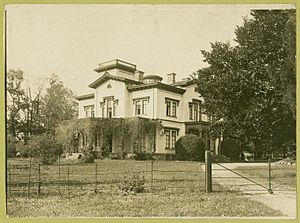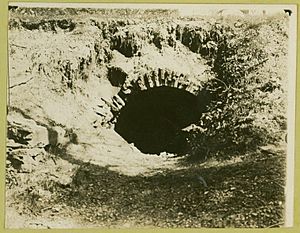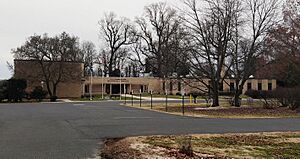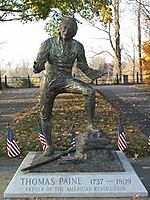Bordentown, New Jersey facts for kids
Quick facts for kids
Bordentown, New Jersey
|
||
|---|---|---|
|
City
|
||
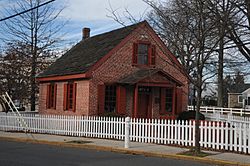
Clara Barton School
|
||
|
||
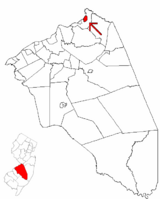
Location of Bordentown in Burlington County highlighted in red (right). Inset map: Location of Burlington County in New Jersey highlighted in red (left).
|
||
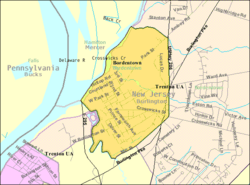
Census Bureau map of Bordentown, New Jersey
|
||
| Country | ||
| State | ||
| County | Burlington | |
| Settled | 1682 | |
| Incorporated | December 9, 1825 (as borough) | |
| Reincorporated | April 3, 1867 (as city) | |
| Named for | Joseph Borden | |
| Government | ||
| • Type | Walsh Act | |
| • Body | Board of Commissioners | |
| Area | ||
| • Total | 0.97 sq mi (2.52 km2) | |
| • Land | 0.94 sq mi (2.42 km2) | |
| • Water | 0.04 sq mi (0.10 km2) 4.02% | |
| Area rank | 504th of 565 in state 36th of 40 in county |
|
| Elevation | 49 ft (15 m) | |
| Population
(2020)
|
||
| • Total | 3,993 | |
| • Estimate
(2023)
|
4,021 | |
| • Rank | 414th of 565 in state 31st of 40 in county |
|
| • Density | 4,272.7/sq mi (1,649.7/km2) | |
| • Density rank | 145th of 565 in state 4th of 40 in county |
|
| Time zone | UTC−05:00 (Eastern (EST)) | |
| • Summer (DST) | UTC−04:00 (Eastern (EDT)) | |
| ZIP Code |
08505
|
|
| Area code(s) | 609 exchanges: 291, 298, 324, 424 | |
| FIPS code | 3400506670 | |
| GNIS feature ID | 0885165 | |
| Website | ||
Bordentown is a city located in Burlington County, New Jersey. In 2020, about 3,993 people lived here. The city is special because it sits where the Delaware River, Blacks Creek, and Crosswicks Creek meet. Crosswicks Creek also forms the border between Burlington and Mercer counties.
Bordentown is the northernmost city in New Jersey that is part of the larger Philadelphia-Reading-Camden area. It's about a third of the way from Center City, Philadelphia to Midtown Manhattan. It is located about 5.8 miles south of the state capital, Trenton.
The first European settlement in this area was in 1682, called Farnsworth's Landing. Later, in 1717, it was renamed Borden's Town. After the American Revolution, Bordentown officially became a borough on December 9, 1825. It then became a city on April 3, 1867.
Contents
Exploring Bordentown's Past
Thomas Farnsworth, an English Quaker, was the first European to settle in the Bordentown area in 1682. He built his home overlooking the Delaware River. This spot, known as "Farnsworth Landing," quickly became a busy trading center. One of Bordentown's main streets, Farnsworth Avenue, is named after him.
Joseph Borden, who the city is named after, arrived in 1717. By 1740, he had created a transportation system. This system moved people and goods between New York City and Philadelphia. Bordentown was a key spot because it offered the shortest land route to Perth Amboy. From there, people and cargo could travel by ferry to New York City. Patience Wright, America's first female sculptor, grew up in Bordentown in the 1730s.
Bordentown During the American Revolution
By 1776, Bordentown was home to many Patriots, people who supported American independence. Joseph Borden's son, also named Joseph Borden, became a colonel in the American Revolutionary War. Other famous Patriots like Thomas Paine and Francis Hopkinson (who signed the United States Declaration of Independence) also lived nearby.
In 1776, Hessian troops (German soldiers fighting for the British) briefly took over Bordentown. They left to fight in the Battle of Iron Works Hill on December 23. On May 8, 1777, British forces attacked Bordentown. They were chasing American soldiers and burned several buildings and military supplies. British forces raided Bordentown again on June 23, 1778, destroying more buildings.
Important Inventions and Schools
In August 1831, a skilled mechanic named Isaac Dripps from Bordentown put together the famous locomotive called the John Bull. He did this in just 10 days without any blueprints! The train was built in England and brought to Philadelphia. It started limited service the next year and regular service the year after. The John Bull became one of the first successful locomotives in the United States. Today, you can see it at the Smithsonian Institution in Washington, D.C.
Another important person from Bordentown was Clara Barton. In 1852, she started the first free public school in New Jersey. Clara Barton later founded the American Red Cross. A replica of her schoolhouse stands at the corner of Crosswicks and Burlington streets.
In 1881, the Bordentown Military Institute opened in a building that was once a girls' seminary. In 1886, Rev. Walter A. Rice started a private school for African-American children. This school later became the Bordentown School, a public school with a large campus. It focused on vocational training and college preparation and operated until 1955.
Joseph Bonaparte's Home in Bordentown
After his family was exiled from France in 1816, Joseph Bonaparte came to Bordentown. He was the former King of Naples and Spain, and the brother of Napoleon I of France. He bought the Point Breeze Estate near Bordentown in 1816. He lived there for 17 years and hosted famous guests like Henry Clay and John Quincy Adams, who later became the 6th U.S. President. The people of Bordentown called him "The Good Mr. Bonaparte."
Joseph Bonaparte built a large lake on his estate. He also built a new home called "Point Breeze" on a hill overlooking the lake. Today, the Divine Word Mission is located on the site of his former estate. Not much of the original estate remains today. You can still see parts of a tunnel that led to the river and the house where Bonaparte's secretary lived.
Bordentown's Location and Surroundings
Bordentown City covers about 0.97 square miles (2.52 square kilometers). Most of this area is land, with a small part being water.
The city is mostly surrounded by Bordentown Township. To the west, it meets the Delaware River and Crosswicks Creek, which forms the border with Hamilton Township in Mercer County. Important roads like U.S. Route 130 and U.S. Route 206 are on its eastern side. Across the Delaware River in Pennsylvania is Falls Township.
People and Population
Bordentown is a small city with a close-knit community. In 2020, the population was 3,993 people. The city has a mix of different backgrounds, with most residents being White, and smaller groups of Black or African American, Asian, and Hispanic or Latino people.
The average household size in Bordentown is about 2.10 people. Many households are made up of individuals, and about 14% of homes have someone living alone who is 65 or older. The median age in the city is around 40.3 years old.
Local Economy and Businesses
Downtown Bordentown is a lively place with many unique shops. You can find book stores, record shops, and antique stores. There are also many restaurants, mostly Italian and American, but also Chinese, Japanese, and Latin-American food. The city is a popular spot for dining out and exploring on weekends.
How Bordentown is Governed
Bordentown has a special type of local government called the Walsh Act system, which it has used since 1913. This means the city is run by three commissioners. One of these commissioners is chosen to be the Mayor. Each commissioner is in charge of a different city department.
The commissioners are elected by all voters in the city for four-year terms. They are elected in non-partisan elections, meaning they don't run as members of a political party. As of 2024, the commissioners are Mayor Jennifer L. Sciortino, Deputy Mayor Joe Myers, and Commissioner Heather Cheesman.
The city's main government building, Bordentown City Hall, is located on the site of the historic Point Breeze estate. This building opened in August 2022.
Emergency Services
Bordentown has a long history of volunteer fire services. The Hope Hose Humane Fire Company 1 started in 1767, making it one of the oldest volunteer fire services in the country. The Consolidated Fire Association was formed in 1966 by combining three other volunteer fire companies.
Environmental Efforts
The Bordentown City Environmental Commission (BCEC) is a group of volunteers who advise the city on environmental issues. They work to protect open spaces, promote walking and biking trails, and ensure clean water. They also focus on recycling, saving energy, and educating the public about environmental care. Recent projects include studies on bicycle and pedestrian paths and developing local greenways.
Education in Bordentown
Public Schools
Students in Bordentown City attend public schools in the Bordentown Regional School District. This district also serves students from Bordentown Township and Fieldsboro Borough. The district has five schools:
- Clara Barton Elementary School (grades K–2)
- Peter Muschal Elementary School (grades PreK–5)
- MacFarland Intermediate School (grades 3–5)
- Bordentown Regional Middle School (grades 6–8)
- Bordentown Regional High School (grades 9–12)
As of the 2023–24 school year, the district had about 2,232 students. Students from New Hanover Township and Wrightstown Borough also attend Bordentown Regional High School.
Students from all of Burlington County can also attend the Burlington County Institute of Technology. This school offers vocational and technical education for high school and adult students at its campuses in Medford and Westampton.
Former Private Schools
Saint Mary School was a Catholic school that served students from Pre-K through 8th grade for over 100 years. It closed in June 2013 due to financial challenges.
The Bordentown Military Institute was located in the city from 1881 to 1972. The Society of the Divine Word also ran a seminary in Bordentown from 1947 to 1983.
Getting Around Bordentown
Bordentown has about 12.73 miles of roads. Major roads like U.S. Route 130 and U.S. Route 206 pass through the city. The New Jersey Turnpike (Interstate 95) and Interstate 295 are nearby in Bordentown Township, providing easy access to the city.
For public transportation, the Bordentown station offers service on NJ Transit's River Line light rail system. This line connects Bordentown to Trenton and Camden. NJ Transit also provides bus service between Trenton and Philadelphia on the 409 route.
Places of Worship
Bordentown City is home to more than 10 different places of worship. These include various churches and the B'nai Abraham Synagogue, showing the city's diverse religious community.
Fun Things to Do and See
Bordentown is a great place to visit for its dining, shops, historical sites, and art galleries. The downtown business association hosts several annual events:
- An Iris Festival & Art Show in early May.
- A Street Fair in mid-to-late May.
- A Cranberry Festival in early October.
The Bordentown Historical Society also organizes events like the Holiday House Tour and Peach Social. They often have exhibits at the Bordentown Friends Meeting House. In 2022, an exhibition of artifacts from Joseph Bonaparte led to a visit from the French ambassador to the United States.
Two important historical sites in Bordentown are listed on the National Register of Historic Places:
- Crosswicks Creek Site III: An archaeological site from the American Revolutionary War era.
- Point Breeze: The former estate of Joseph Bonaparte, recognized for its architecture and history.
Notable People from Bordentown
Many interesting people have lived in or are connected to Bordentown:
- Clara Barton (1821–1912): Started the first free public school in New Jersey and founded the American Red Cross.
- Joseph Bonaparte (1768–1844): Former King of Naples and Spain, and brother of Napoleon I.
- Francis Hopkinson (1737–1791): An author who signed the United States Declaration of Independence.
- Thomas Paine (1737–1809): A key writer and thinker during the American and French Revolutions, known for "Common Sense."
- Patience Wright (1725–1786): America's first native-born sculptor.
- Susan Waters (1823–1900): A painter and photographer who supported women's voting rights and animal rights.
- Ricardo Almeida (born 1976): A Brazilian-American mixed martial artist.
- Dionne Farris (born 1968): A singer-songwriter.
- Ishod Wair (born 1991): A professional skateboarder.
See also
 In Spanish: Bordentown para niños
In Spanish: Bordentown para niños






